Analyzing Trends in Green Financial Instrument Issuance for Climate Finance in Capital Markets
Abstract
1. Introduction
- What is the scientific trend in the literature on green financial instrument issuances via capital markets?
- Does the scientific journal productivity on climate finance in capital markets follow Bradford’s bibliometric law?
- Does the author’s productivity align with Lotka’s bibliometric law in the literature on green financial instrument issuance in capital markets?
- What are the status and linkages in the literature on green financial instrument issuances via capital markets based on conceptual and social structures?
- Does the word frequency in the literature on green financial instrument issuances via capital markets confirm Zipf’s bibliometric law?
- What are the trending topics and emerging themes from the literature on climate finance in capital markets?
2. Materials and Methods
2.1. Research Framework
2.2. Nature of Data
TS = (((“green financial instrument*”) OR (“green securit*”) OR (“green instrument*” ) OR ( “green equity*”) OR (“green inde*”) OR (“green bond*”) OR (“green stock*”) OR (“green investment*”) OR (“climate finance*”) OR (“Green finance*”)) AND ((“stock exchange*”) OR (“capital market*”) OR (“financial market*”) OR (“securit exchange*”) OR (“Listed compa*”) OR (“listed corporation*”)))
3. Results and Discussion
3.1. Overview
3.1.1. Scientific Production Trend
3.1.2. Core Sources Based on Bradford’s Law
3.1.3. Top Relevant Sources by Co-Citation Analysis
3.1.4. Author Productivity via Lotka’s Law Lens
3.2. Conceptual Structure
3.2.1. Word Cloud
3.2.2. Keyword Frequency via Zipf’s Law Lens
3.2.3. Keyword Co-Occurrence Network
3.2.4. Trend Topics and Thematic Map
| Main Clusters | Callon Centrality | Callon Density |
|---|---|---|
| Financial markets | 0.574494949 | 38.38383838 |
| green investment | 0.370435977 | 26.45356754 |
| fintech | 0.145833333 | 42.22222222 |
| green bonds | 1.347510758 | 28.5799679 |
| economic policy uncertainty | 0 | 25 |
| risk spillovers | 0 | 33.33333333 |
3.3. Social Structure
3.3.1. Countries Collaboration
3.3.2. Author Collaboration
3.3.3. Affiliation Collaboration
4. Conclusions, Future Research Possibilities, and Limitations
Author Contributions
Funding
Data Availability Statement
Acknowledgments
Conflicts of Interest
| 1 | Section 3.1.2 Core sources based on Bradford’s law. |
| 2 | Section 3.1.4 Author productivity via Lotka’s law lens. |
| 3 | Section 3.2.2 Keyword frequency via Zipf’s Law lens. |
References
- African Development Bank. 2019. Climate Change in Africa. Text. African Development Bank—Building Today, a Better Africa Tomorrow. Abidjan: African Development Bank Group. Available online: https://www.afdb.org/en/cop25/climate-change-africa (accessed on 28 November 2023).
- Alhamar, Fatema, Allam Hamdan, and Mohamad Saif. 2024. Environmental, Social, and Governance (ESG) Impact on Firm’s Performance. In Artificial Intelligence and Transforming Digital Marketing. Edited by Allam Hamdan and Esra Saleh Aldhaen. Studies in Systems, Decision and Control. Cham: Springer Nature, pp. 461–75. [Google Scholar] [CrossRef]
- Almeida, Luís. 2023. Risk and Bankruptcy Research: Mapping the State of the Art. Journal of Risk and Financial Management 16: 361. [Google Scholar] [CrossRef]
- Almeida, Luís, and Elisabete Vieira. 2023. Technical Analysis, Fundamental Analysis, and Ichimoku Dynamics: A Bibliometric Analysis. Risks 11: 142. [Google Scholar] [CrossRef]
- Anderloni, Luisa, and Alessandra Tanda. 2017. Green Energy Companies: Stock Performance and IPO Returns. Research in International Business and Finance 39: 546–52. [Google Scholar] [CrossRef]
- Aparicio, Gloria, Txomin Iturralde, and Amaia Maseda. 2019. Conceptual Structure and Perspectives on Entrepreneurship Education Research: A Bibliometric Review. European Research on Management and Business Economics 25: 105–13. [Google Scholar] [CrossRef]
- Aria, Massimo, and Corrado Cuccurullo. 2017. Bibliometrix: An R-Tool for Comprehensive Science Mapping Analysis. Journal of Informetrics 11: 959–75. [Google Scholar] [CrossRef]
- Arif, Muhammad, Muhammad Abubakr Naeem, Saqib Farid, Rabindra Nepal, and Tooraj Jamasb. 2022. Diversifier or More? Hedge and Safe Haven Properties of Green Bonds during COVID-19. Energy Policy 168: 113102. [Google Scholar] [CrossRef] [PubMed]
- Banga, Josué. 2019. The Green Bond Market: A Potential Source of Climate Finance for Developing Countries. Journal of Sustainable Finance & Investment 9: 17–32. [Google Scholar] [CrossRef]
- Baulkaran, Vishaal. 2019. Stock Market Reaction to Green Bond Issuance. Journal of Asset Management 20: 331–40. [Google Scholar] [CrossRef]
- Benomar, Lahcen, Raed Elferjani, Jill Hamilton, Greg A. O’Neill, Said Echchakoui, Yves Bergeron, and Mebarek Lamara. 2022. Bibliometric Analysis of the Structure and Evolution of Research on Assisted Migration. Current Forestry Reports 8: 199–213. [Google Scholar] [CrossRef]
- Birkle, Caroline, David A. Pendlebury, Joshua Schnell, and Jonathan Adams. 2020. Web of Science as a Data Source for Research on Scientific and Scholarly Activity. Quantitative Science Studies 1: 363–76. [Google Scholar] [CrossRef]
- Bookstein, Abraham. 1976. The Bibliometric Distributions. The Library Quarterly: Information, Community, Policy 46: 416–23. [Google Scholar]
- Branca, Giacomo, Ademola Braimoh, Yuxuan Zhao, Motselisi Ratii, and Puseletso Likoetla. 2021. Are There Opportunities for Climate-Smart Agriculture? Assessing Costs and Benefits of Sustainability Investments and Planning Policies in Southern Africa. Journal of Cleaner Production 278: 123847. [Google Scholar] [CrossRef]
- Broadus, Robert N. 1987. Toward a Definition of ‘Bibliometrics’. Scientometrics 12: 373–79. [Google Scholar] [CrossRef]
- Callon, Michel, Jean Pierre Courtial, and Francoise Laville. 2005. Co-Word Analysis as a Tool for Describing the Network of Interactions between Basic and Technological Research: The Case of Polymer Chemsitry. Scientometrics 22: 155–205. [Google Scholar] [CrossRef]
- Callon, Michel, Jean-Pierre Courtial, William A. Turner, and Serge Bauin. 1983. From Translations to Problematic Networks: An Introduction to Co-Word Analysis. Social Science Information 22: 191–235. [Google Scholar] [CrossRef]
- Calvet, Laurent, Gianfranco Gianfrate, and Raman Uppal. 2022. The Finance of Climate Change. Journal of Corporate Finance 73: 102162. [Google Scholar] [CrossRef]
- Candra, Oriza, Abdeljelil Chammam, José Ricardo Nuñez Alvarez, Iskandar Muda, and Hikmet Ş. Aybar. 2023. The Impact of Renewable Energy Sources on the Sustainable Development of the Economy and Greenhouse Gas Emissions. Sustainability 15: 2104. [Google Scholar] [CrossRef]
- Chen, Xingxing, Olaf Weber, and Vasundhara Saravade. 2022. Does It Pay to Issue Green? An Institutional Comparison of Mainland China and Hong Kong’s Stock Markets Toward Green Bonds. Frontiers in Psychology 13: 833847. [Google Scholar] [CrossRef]
- Chen, Yi, Zhongwen Xu, Xuehao Wang, and Yining Yang. 2023. How Does Green Credit Policy Improve Corporate Social Responsibility in China? An Analysis Based on Carbon-Intensive Listed Firms. Corporate Social Responsibility and Environmental Management 30: 889–904. [Google Scholar] [CrossRef]
- Chi, Yi, Ning Hu, Dong Lu, and Yang Yang. 2023. Green Investment Funds and Corporate Green Innovation: From the Logic of Social Value. Energy Economics 119: 106532. [Google Scholar] [CrossRef]
- Climate Change Is an Increasing Threat to Africa|UNFCCC. n.d. Available online: https://unfccc.int/news/climate-change-is-an-increasing-threat-to-africa (accessed on 1 August 2022).
- Cobo, Manuel J., A. G. López-Herrera, Enrique Herrera-Viedma, and Francisco Herrera. 2011. An Approach for Detecting, Quantifying, and Visualizing the Evolution of a Research Field: A Practical Application to the Fuzzy Sets Theory Field. Journal of Informetrics 5: 146–66. [Google Scholar] [CrossRef]
- Crane, Diana. 1969. Social Structure in a Group of Scientists: A Test of the ‘Invisible College’ Hypothesis. American Sociological Review 34: 335–52. [Google Scholar] [CrossRef]
- Desai, Nidhi, Laura Veras, and Ankush Gosain. 2018. Using Bradford’s Law of Scattering to Identify the Core Journals of Pediatric Surgery. Journal of Surgical Research 229: 90–95. [Google Scholar] [CrossRef]
- Dong, Zhao, Haodong Xu, Zhifeng Zhang, Yipin Lyu, Yuqi Lu, and Hongyan Duan. 2022. Whether Green Finance Improves Green Innovation of Listed Companies—Evidence from China. International Journal of Environmental Research and Public Health 19: 882. [Google Scholar] [CrossRef]
- Donthu, Naveen, Satish Kumar, Debmalya Mukherjee, Nitesh Pandey, and Weng Marc Lim. 2021. How to Conduct a Bibliometric Analysis: An Overview and Guidelines. Journal of Business Research 133: 285–96. [Google Scholar] [CrossRef]
- Du Pisani, Jacobus A. 2006. Sustainable Development—Historical Roots of the Concept. Environmental Sciences 3: 83–96. [Google Scholar] [CrossRef]
- Egghe, Leo. 1990. Applications of the Theory of Bradford’s Law to the Calculation of Leimkuhler’s Law and to the Completion of Bibliographies. Journal of the American Society for Information Science 41: 469–92. [Google Scholar] [CrossRef]
- El Khoury, Rim, Nohade Nasrallah, Khaled Hussainey, and Rima Assaf. 2023. Spillover Analysis across FinTech, ESG, and Renewable Energy Indices before and during the Russia–Ukraine War: International Evidence. Journal of International Financial Management & Accounting 34: 279–317. [Google Scholar] [CrossRef]
- Elsayed, Ahmed H., ader Naifar, Samia Nasreen, and Aviral Kumar Tiwari. 2022. Dependence Structure and Dynamic Connectedness between Green Bonds and Financial Markets: Fresh Insights from Time-Frequency Analysis before and during COVID-19 Pandemic. Energy Economics 107: 105842. [Google Scholar] [CrossRef]
- European Investment Bank. n.d. Europeans Are More Concerned about Climate Change Than People in the USA and China. Luxembourg: European Investment Bank. Available online: https://www.eib.org/en/infographics/eu-climate-change-peer-us-china (accessed on 11 October 2023).
- Flammer, Caroline. 2018. Corporate Green Bonds. The Journal of Financial Economics 41. [Google Scholar] [CrossRef]
- Gunningham, Neil. 2020. A Quiet Revolution: Central Banks, Financial Regulators, and Climate Finance. Sustainability 12: 9596. [Google Scholar] [CrossRef]
- Ha, Phan Thanh. 2009. China Green Credit Policy. Business Issues Bulletin, Vietnam 54370. Available online: https://documents1.worldbank.org/curated/zh/960771468261298975/pdf/543700BRI0ENGL1BOX0349405B01PUBLIC1.pdf (accessed on 27 October 2023).
- Hadas-Dyduch, Monika, Blandyna Puszer, Maria Czech, and Janusz Cichy. 2022. Green Bonds as an Instrument for Financing Ecological Investments in the V4 Countries. Sustainability 14: 2188. [Google Scholar] [CrossRef]
- Hearst, Marti A., Emily Pedersen, Lekha Patil, Elsie Lee, Paul Laskowski, and Steven Franconeri. 2020. An Evaluation of Semantically Grouped Word Cloud Designs. IEEE Transactions on Visualization and Computer Graphics 26: 2748–61. [Google Scholar] [CrossRef] [PubMed]
- Hu, Jun, Juncheng Li, Xiangyu Li, Yueyue Liu, Wenwei Wang, and Liansheng Zheng. 2021. Will Green Finance Contribute to a Green Recovery? Evidence from Green Financial Pilot Zone in China. Frontiers in Public Health 9: 794195. [Google Scholar] [CrossRef] [PubMed]
- Huang, Lingyun, and Zhuojun Lei. 2021. How Environmental Regulation Affect Corporate Green Investment: Evidence from China. Journal of Cleaner Production 279: 123560. [Google Scholar] [CrossRef]
- Huang, Xiaobing, Yousaf Ali Khan, Noman Arshed, Sultan Salem, Muhammad Ghulam Shabeer, and Uzma Hanif. 2023. Increasing Social Resilience against Climate Change Risks: A Case of Extreme Climate Affected Countries. International Journal of Climate Change Strategies and Management 15: 412–31. [Google Scholar] [CrossRef]
- Huber, John C. 1998. The Underlying Process Generating Lotka’s Law and the Statistics of Exceedances. Information Processing & Management 34: 471–87. [Google Scholar] [CrossRef]
- Indriastuti, Maya, and Anis Chariri. 2021. The Role of Green Investment and Corporate Social Responsibility Investment on Sustainable Performance. Cogent Business & Management 8: 1960120. [Google Scholar] [CrossRef]
- Janik, Agnieszka, Adam Ryszko, and Marek Szafraniec. 2021. Exploring the Social Innovation Research Field Based on a Comprehensive Bibliometric Analysis. Journal of Open Innovation: Technology, Market, and Complexity 7: 226. [Google Scholar] [CrossRef]
- Jiang, Dongming, and Fang Jia. 2022. Extreme Spillover between Green Bonds and Clean Energy Markets. Sustainability 14: 6338. [Google Scholar] [CrossRef]
- Jiang, Shuangshuang, Xiaojiao Liu, Zhonglu Liu, Hao Shi, and Hongdi Xu. 2022a. Does Green Finance Promote Enterprises’ Green Technology Innovation in China? Frontiers in Environmental Science 10: 981013. [Google Scholar] [CrossRef]
- Jiang, Yonghong, Jieru Wang, Zhiming Ao, and Yujou Wang. 2022b. The Relationship between Green Bonds and Conventional Financial Markets: Evidence from Quantile-on-Quantile and Quantile Coherence Approaches. Economic Modelling 116: 106038. [Google Scholar] [CrossRef]
- Khare, Apoorv, and Rajesh Jain. 2022. Mapping the Conceptual and Intellectual Structure of the Consumer Vulnerability Field: A Bibliometric Analysis. Journal of Business Research 150: 567–84. [Google Scholar] [CrossRef]
- Kiseleva, Elena. G., and Aleksei M. Efimov. 2019. Green Bonds as A Tool for Sustainable Development on Emerging Markets. St. Petersburg: Peter the Great St. Petersburg Polytechnic University, pp. 5619–27. [Google Scholar]
- Laborda, Juan, and Alvaro Sanchez-Guerra. 2021. Green Bond Finance in Europe and the Stock Market Reaction. Estudios De Economia Aplicada 39. [Google Scholar] [CrossRef]
- Lai, Hongyi. 2021. The Evolution of China’s Climate Change Policy: International and Domestic Political Economy and a Strategy for Working with China. Journal of the British Academy 9: 69–98. [Google Scholar] [CrossRef]
- Lakner, Zoltán, Brigitta Plasek, Gyula Kasza, Anna Kiss, Sándor Soós, and Ágoston Temesi. 2021. Towards Understanding the Food Consumer Behavior–Food Safety–Sustainability Triangle: A Bibliometric Approach. Sustainability 13: 12218. [Google Scholar] [CrossRef]
- Li, Xiuping, and Ye Yang. 2022. Does Green Finance Contribute to Corporate Technological Innovation? The Moderating Role of Corporate Social Responsibility. Sustainability 14: 5648. [Google Scholar] [CrossRef]
- Limaymanta, Cesar H., Rosalía Quiroz-de-García, Jesús A. Rivas-Villena, Andrea Rojas-Arroyo, and Orlando Gregorio-Chaviano. 2022. Relationship between Collaboration and Normalized Scientific Impact in South American Public Universities. Scientometrics 127: 6391–411. [Google Scholar] [CrossRef]
- Lorente, Daniel Balsalobre, Kamel Si Mohammed, Javier Cifuentes-Faura, and Umer Shahzad. 2023. Dynamic Connectedness among Climate Change Index, Green Financial Assets and Renewable Energy Markets: Novel Evidence from Sustainable Development Perspective. Renewable Energy 204: 94–105. [Google Scholar] [CrossRef]
- Lu, Yuchen, Yuqiang Gao, Yu Zhang, and Junrong Wang. 2022. Can the Green Finance Policy Force the Green Transformation of High-Polluting Enterprises? A Quasi-Natural Experiment Based on ‘Green Credit Guidelines’. Energy Economics 114: 106265. [Google Scholar] [CrossRef]
- Luto, Waltman. 2016. A Review of the Literature on Citation Impact Indicators. Journal of Informetrics 10: 365–91. [Google Scholar] [CrossRef]
- Ma, Mengjuan, Xiao Zhu, Meishan Liu, and Xiaodong Huang. 2023. Combining the Role of Green Finance and Environmental Sustainability on Green Economic Growth: Evidence from G-20 Economies. Renewable Energy 207: 128–36. [Google Scholar] [CrossRef]
- Mankata, Lawrence Martin, De-Graft Owusu-Manu, M. Reza Hosseini, and David John Edwards. 2022. Analysis of Success-Dependent Factors for Green Bond Financing of Infrastructure Projects in Ghana. Journal of Sustainable Finance & Investment 12: 832–48. [Google Scholar] [CrossRef]
- Mensi, Walid, Muhammad Shafiullah, Xuan Vinh Vo, and Sang Hoon Kang. 2022. Spillovers and Connectedness between Green Bond and Stock Markets in Bearish and Bullish Market Scenarios. Finance Research Letters 49: 103120. [Google Scholar] [CrossRef]
- Mocanu, Mihaela, Laura-Gabriela Constantin, and Bogdan Cernat-Gruici. 2021. Sustainability bonds. An international event study. Journal of Business Economics and Management 22: 1551–76. [Google Scholar] [CrossRef]
- Muchiri, Martin Kamau, Szilvia Erdei-Gally, Mária Fekete-Farkas, and Zoltán Lakner. 2022. Bibliometric Analysis of Green Finance and Climate Change in Post-Paris Agreement Era. Journal of Risk and Financial Management 15: 561. [Google Scholar] [CrossRef]
- Naeem, Muhammad Abubakr, Imen Mbarki, Majed Alharthi, Abdelwahed Omri, and Syed Jawad Hussain Shahzad. 2021. Did COVID-19 Impact the Connectedness Between Green Bonds and Other Financial Markets? Evidence from Time-Frequency Domain with Portfolio Implications. Frontiers in Environmental Science 9: 657533. [Google Scholar] [CrossRef]
- OECD. 2022. Aggregate Trends of Climate Finance Provided and Mobilised by Developed Countries in 2013–2020. Climate Finance and the USD 100 Billion Goal. Paris: OECD. [Google Scholar] [CrossRef]
- Ongoma, Victor, Terence Epule Epule, Youssef Brouziyne, Meryem Tanarhte, and Abdelghani Chehbouni. 2023. COVID-19 Response in Africa: Impacts and Lessons for Environmental Management and Climate Change Adaptation. Environment, Development and Sustainability 26: 5537–59. [Google Scholar] [CrossRef]
- Ozili, Peterson K., and Ercan Ozen. 2023. Global Energy Crisis. In The Impact of Climate Change and Sustainability Standards on the Insurance Market. Beverly: Scrivener Publishing LLC, pp. 439–54. [Google Scholar] [CrossRef]
- Pauw, W. Pieter. 2021. The Adaptation Finance Gap Can Only Be Closed by Limiting the Adaptation Costs. One Earth 4: 1352–55. [Google Scholar] [CrossRef]
- Powell, Kimberly R., and Shenita R. Peterson. 2017. Coverage and Quality: A Comparison of Web of Science and Scopus Databases for Reporting Faculty Nursing Publication Metrics. Nursing Outlook 65: 572–78. [Google Scholar] [CrossRef]
- Prakash, Nisha, and Madhvi Sethi. 2022. A Review of Innovative Bond Instruments for Sustainable Development in Asia. International Journal of Innovation Science 14: 630–47. [Google Scholar] [CrossRef]
- Purkayastha, Dhruba, and Runa Sarkar. 2021. Getting Financial Markets to Work for Climate Finance. Journal of Structured Finance 27: 27–41. [Google Scholar] [CrossRef]
- Quoniam, Luc, Frédéric Balme, Hervé Rostaing, Eric Giraud, and Jean Marie Dou. 1998. Bibliometric Law Used for Information Retrieval. Scientometrics 41: 83–91. [Google Scholar] [CrossRef]
- Rani, Monika, Serena Ducoli, Stefania Federici, and Laura Eleonora Depero. 2023. Influx of Near-Infrared Technology in Microplastic Community: A Bibliometric Analysis. Microplastics 2: 107–21. [Google Scholar] [CrossRef]
- Rao, Amar, Mansi Gupta, Gagan Deep Sharma, Mandeep Mahendru, and Anirudh Agrawal. 2022a. Revisiting the Financial Market Interdependence during COVID-19 Times: A Study of Green Bonds, Cryptocurrency, Commodities and Other Financial Markets. International Journal of Managerial Finance 18: 725–55. [Google Scholar] [CrossRef]
- Rao, Huacheng, Dongxu Chen, Feichao Shen, and Yangyang Shen. 2022b. Can Green Bonds Stimulate Green Innovation in Enterprises? Evidence from China. Sustainability 14: 5631. [Google Scholar] [CrossRef]
- Ren, Xiaohang, Yiying Li, Cheng Yan, Fenghua Wen, and Zudi Lu. 2022. The Interrelationship between the Carbon Market and the Green Bonds Market: Evidence from Wavelet Quantile-on-Quantile Method. Technological Forecasting and Social Change 179: 121611. [Google Scholar] [CrossRef]
- Rocha, Jorge, Sandra Oliveira, Cláudia M. Viana, and Ana Isabel Ribeiro. 2022. Chapter 8—Climate Change and Its Impacts on Health, Environment and Economy. In One Health. Edited by Joana C. Prata, Ana Isabel Ribeiro and Teresa Rocha-Santos. Cambridge: Academic Press, pp. 253–79. [Google Scholar] [CrossRef]
- Sahu, Archana, and Puspanjali Jena. 2021. Lotka’s Law and Author Productivity Pattern of Research in Law Discipline. Collection and Curation 41: 62–73. [Google Scholar] [CrossRef]
- Santos, Filipe Duarte, Paulo Lopes Ferreira, and Jiesper Strandsbjerg Tristan Pedersen. 2022. The Climate Change Challenge: A Review of the Barriers and Solutions to Deliver a Paris Solution. Climate 10: 75. [Google Scholar] [CrossRef]
- Scimago Journal & Country Rank. n.d. Available online: https://www.scimagojr.com/index.php (accessed on 21 September 2023).
- Scoville-Simonds, Morgan. 2016. The Governance of Climate Change Adaptation Finance—An Overview and Critique. International Development Policy|Revue Internationale de Politique de Développement 7. [Google Scholar] [CrossRef]
- Shirai, Sayuri. 2023. Green Central Banking and Regulation to Foster Sustainable Finance. Tokyo: Asian Development Bank Institute. [Google Scholar] [CrossRef]
- Sivertsen, Gunnar, Ronald Rousseau, and Lin Zhang. 2019. Measuring Scientific Contributions with Modified Fractional Counting. Journal of Informetrics 13: 679–94. [Google Scholar] [CrossRef]
- Stern, Nicholas. 2022. A Time for Action on Climate Change and a Time for Change in Economics. The Economic Journal 132: 1259–89. [Google Scholar] [CrossRef]
- Su, Tong, Zuopeng Justin Zhang, and Boqiang Lin. 2022. Green Bonds and Conventional Financial Markets in China: A Tale of Three Transmission Modes. Energy Economics 113: 106200. [Google Scholar] [CrossRef]
- Summers, Edward G. 1983. Bradford’s Law and the Retrieval of Reading Research Journal Literature. Reading Research Quarterly 19: 102–9. [Google Scholar] [CrossRef]
- Sustainable Stock Exchange Initiative. 2017. How Stock Exchanges Can Grow Green Finance a Voluntary Action Plan. New York: Sustainable Stock Exchange Initiative. Available online: https://sseinitiative.org/wp-content/uploads/2019/12/SSE-Green-Finance-Guidance-.pdf (accessed on 19 October 2023).
- Tripathy, Aneil. 2017. Translating to Risk: The Legibility of Climate Change and Nature in the Green Bond Market. Economic Anthropology 4: 239–50. [Google Scholar] [CrossRef]
- Umar, Muhammad, Yasir Riaz, and Imran Yousaf. 2022. Impact of Russian-Ukraine War on Clean Energy, Conventional Energy, and Metal Markets: Evidence from Event Study Approach. Resources Policy 79: 102966. [Google Scholar] [CrossRef]
- UNFCCC. 2015. Adoption of the Paris Agreement. Bonn: United Nations Framework Convention on Climate Change. Available online: https://unfccc.int/resource/docs/2015/cop21/eng/l09r01.pdf (accessed on 3 October 2023).
- United Nations Environment Programme. 2022. Adaptation Gap Report 2022: Too Little, Too Slow—Climate Adaptation Failure Puts World at Risk. Available online: https://www.unep.org/resources/adaptation-gap-report-2022 (accessed on 3 October 2023).
- van Eck, Nees Jan, and Ludo Waltman. 2010. Software Survey: VOSviewer, a Computer Program for Bibliometric Mapping. Scientometrics 84: 523–38. [Google Scholar] [CrossRef] [PubMed]
- Verma, Rakesh Kumar, and Rohit Bansal. 2023. Stock Market Reaction on Green-Bond Issue: Evidence from Indian Green-Bond Issuers. Vision-The Journal of Business Perspective 27: 264–72. [Google Scholar] [CrossRef]
- Wiafe, Nti Akenten, Charles Boateng, and Haftamu Kiros. 2020. The Role of Capital Markets in Economic Growth: Evidence from Ghana. Social Science Research Network Scholarly Paper. Available online: https://www.readcube.com/articles/10.2139%2Fssrn.3530744 (accessed on 3 October 2023).
- World Meteorological Organization. 2022. State of the Climate in Latin America and the Caribbean 2021 (WMO-No. 1295). Geneva: WMO. [Google Scholar]
- Wright, Helena, Saleemul Huq, and Jonathan Reeves. 2015. Impact of Climate Change on Least Developed Countries. London: International Institute for Environment and Development-JSTOR. [Google Scholar]
- Wu, Gabriel Shui Tang, and Wilson Tsz Shing Wan. 2023. What Drives the Cross-Border Spillover of Climate Transition Risks? Evidence from Global Stock Markets. International Review of Economics & Finance 85: 432–47. [Google Scholar] [CrossRef]
- Xi, Bin, and Huimin Jing. 2022. Research on the Impact of Green Bond Issuance on the Stock Price of Listed Companies. Kybernetes 51: 1478–97. [Google Scholar] [CrossRef]
- Yang, Lu, Jie Li, Wenhuan Lu, Yi Chen, Kang Zhang, and Yan Li. 2020. The Influence of Font Scale on Semantic Expression of Word Cloud. Journal of Visualization 23: 981–98. [Google Scholar] [CrossRef]
- Yenneti, Komali, Sabyasachi Tripathi, Yehua Dennis Wei, Wen Chen, and Gaurav Joshi. 2016. The Truly Disadvantaged? Assessing Social Vulnerability to Climate Change in Urban India. Habitat International 56: 124–35. [Google Scholar] [CrossRef]
- Yu, Yunlong, Zhao Jin, and Junping Qiu. 2021. Global Isotopic Hydrograph Separation Research History and Trends: A Text Mining and Bibliometric Analysis Study. Water 13: 2529. [Google Scholar] [CrossRef]
- Zhang, Shengling, Zihao Wu, Yao Wang, and Yu Hao. 2021. Fostering Green Development with Green Finance: An Empirical Study on the Environmental Effect of Green Credit Policy in China. Journal of Environmental Management 296: 113159. [Google Scholar] [CrossRef]
- Zhang, Wei, Qingpu Zhang, Bo Yu, and Limei Zhao. 2015. Knowledge Map of Creativity Research Based on Keywords Network and Co-Word Analysis, 1992–2011. Quality & Quantity 49: 1023–38. [Google Scholar] [CrossRef]
- Zhou, Xiaoguang, and Yadi Cui. 2019. Green Bonds, Corporate Performance, and Corporate Social Responsibility. Sustainability 11: 6881. [Google Scholar] [CrossRef]
- Zhou, Yaning. 2019. Development of Green Bond Market in Chin. Beijing: Peking University, vol. 319, pp. 448–51. [Google Scholar]
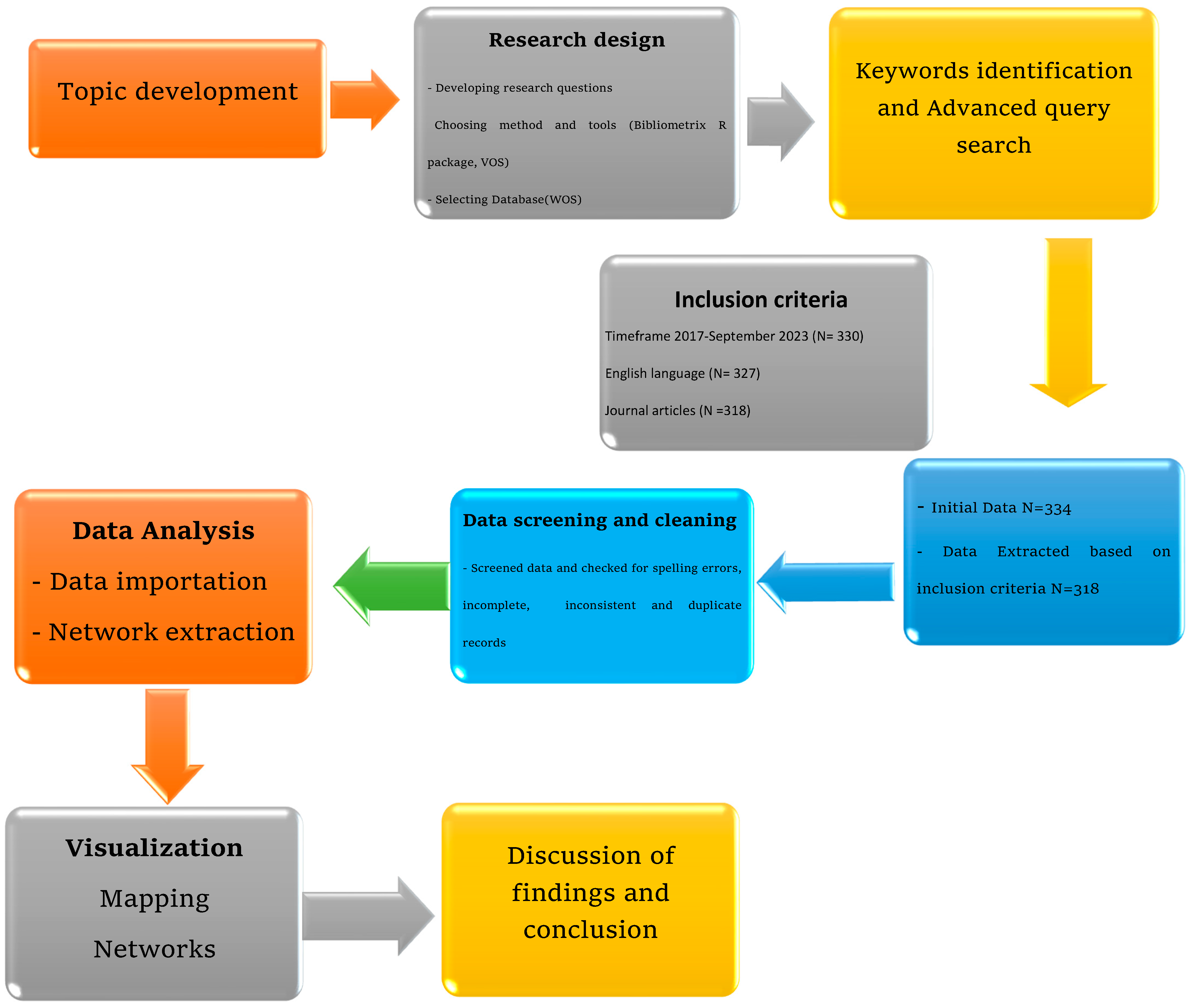
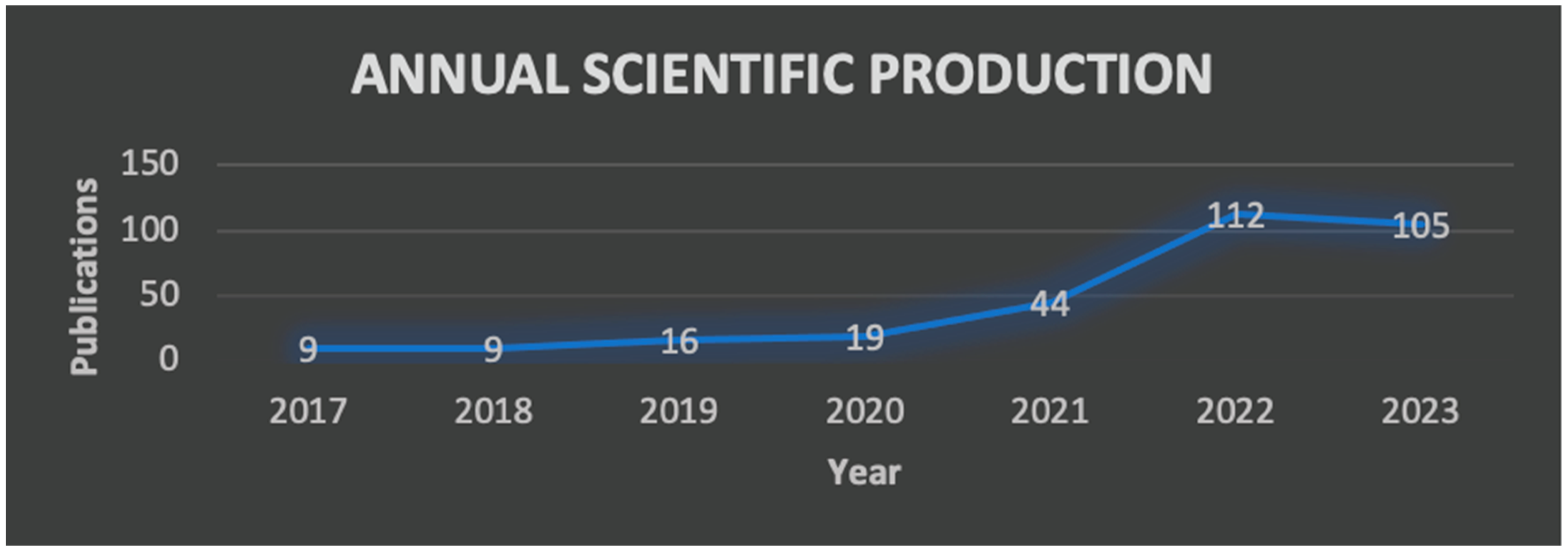
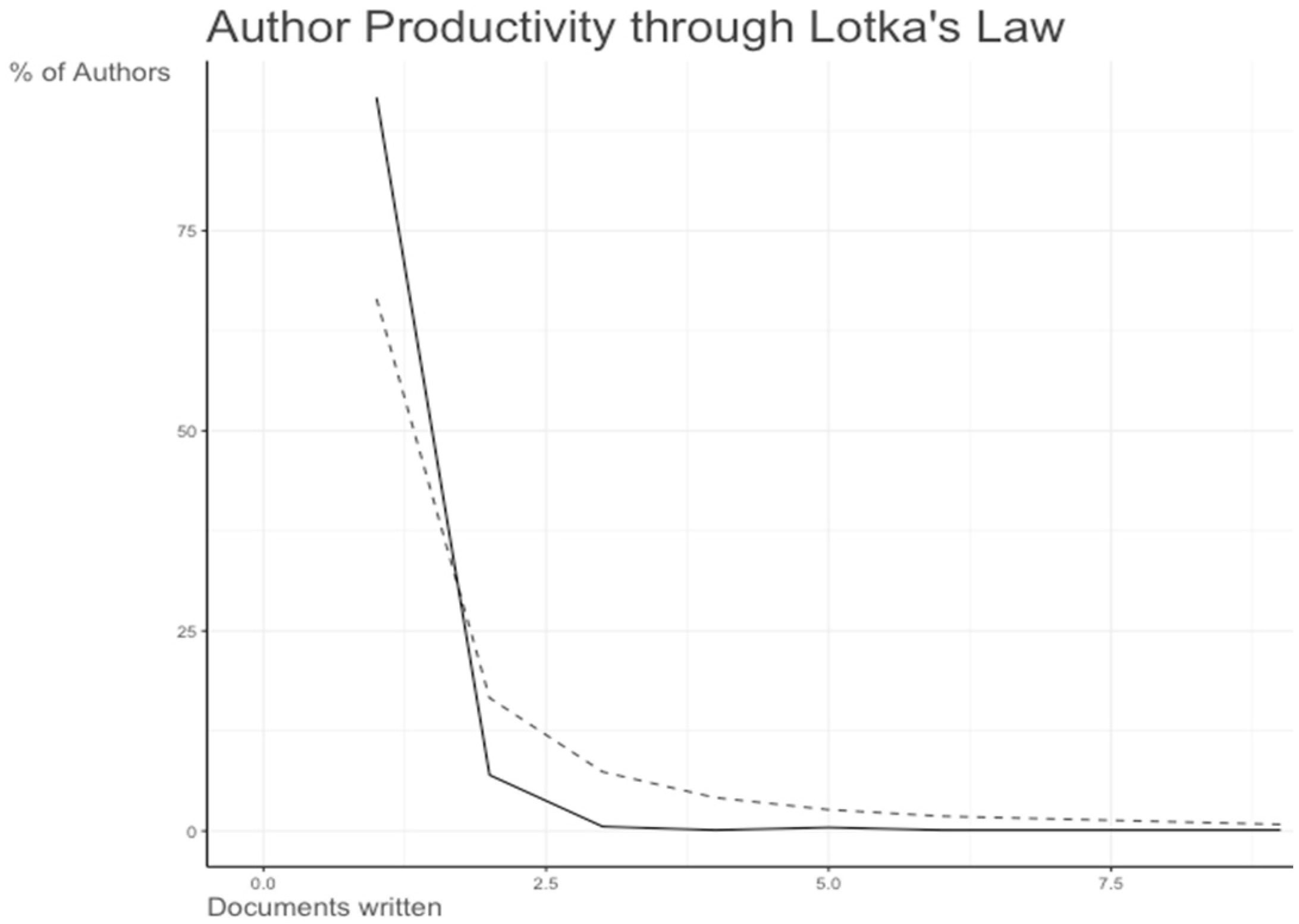
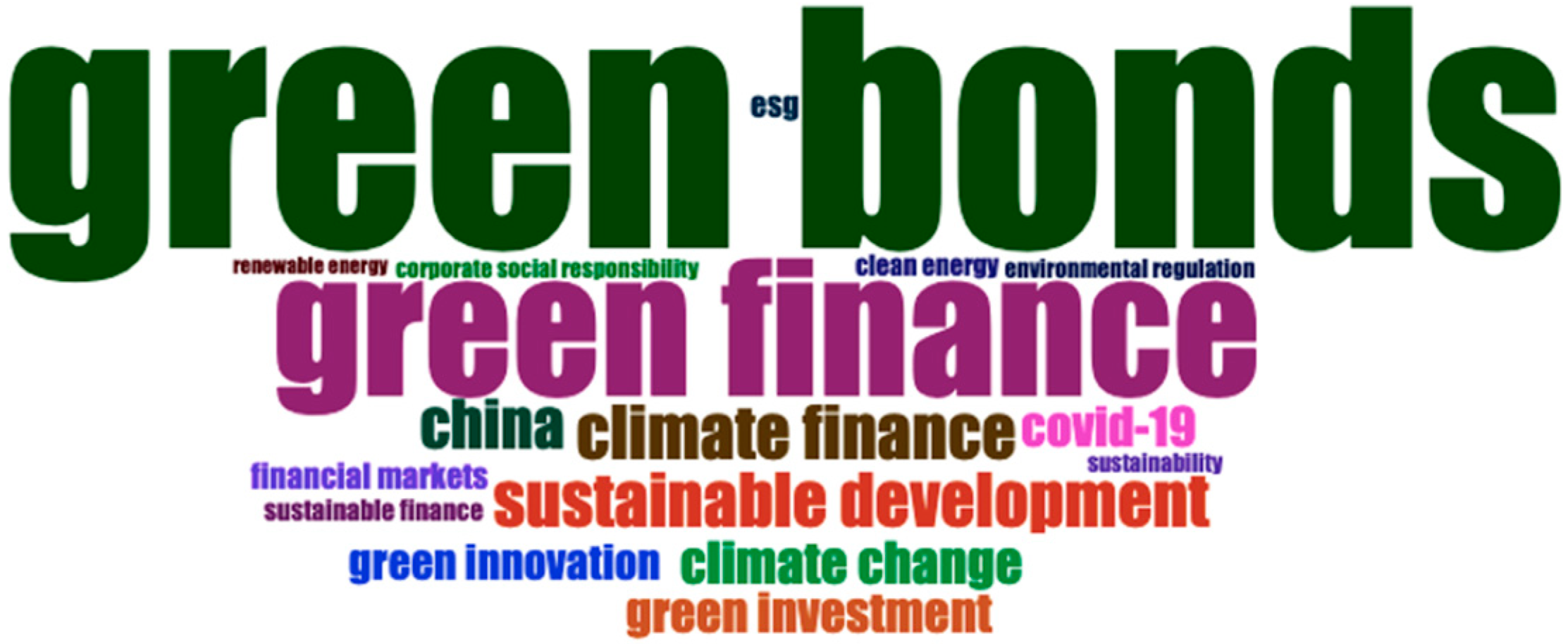
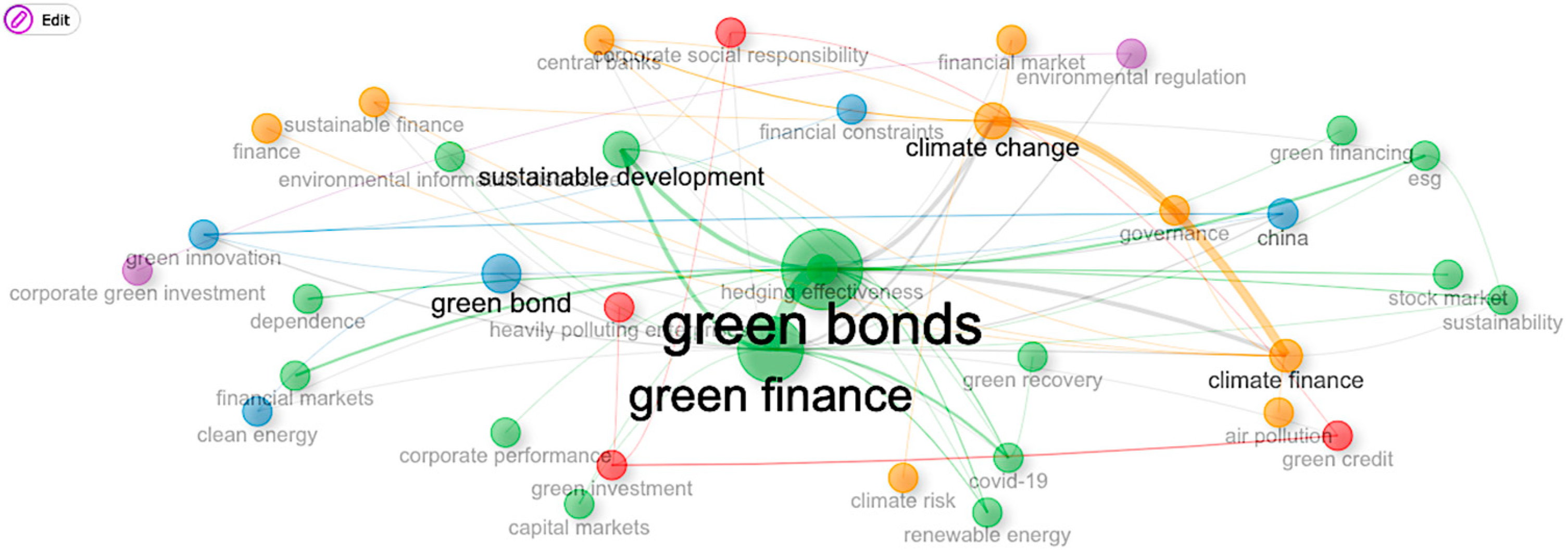
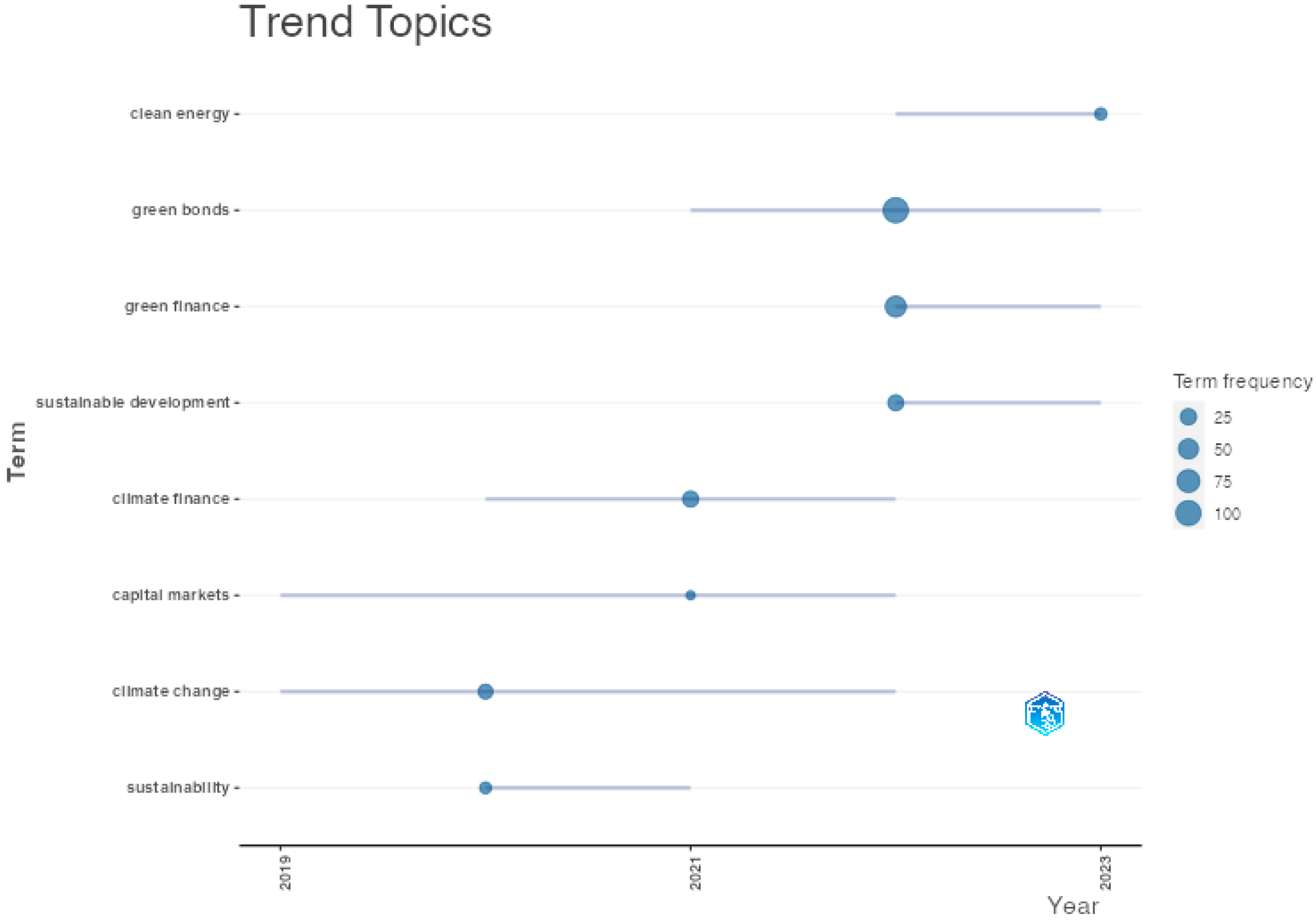
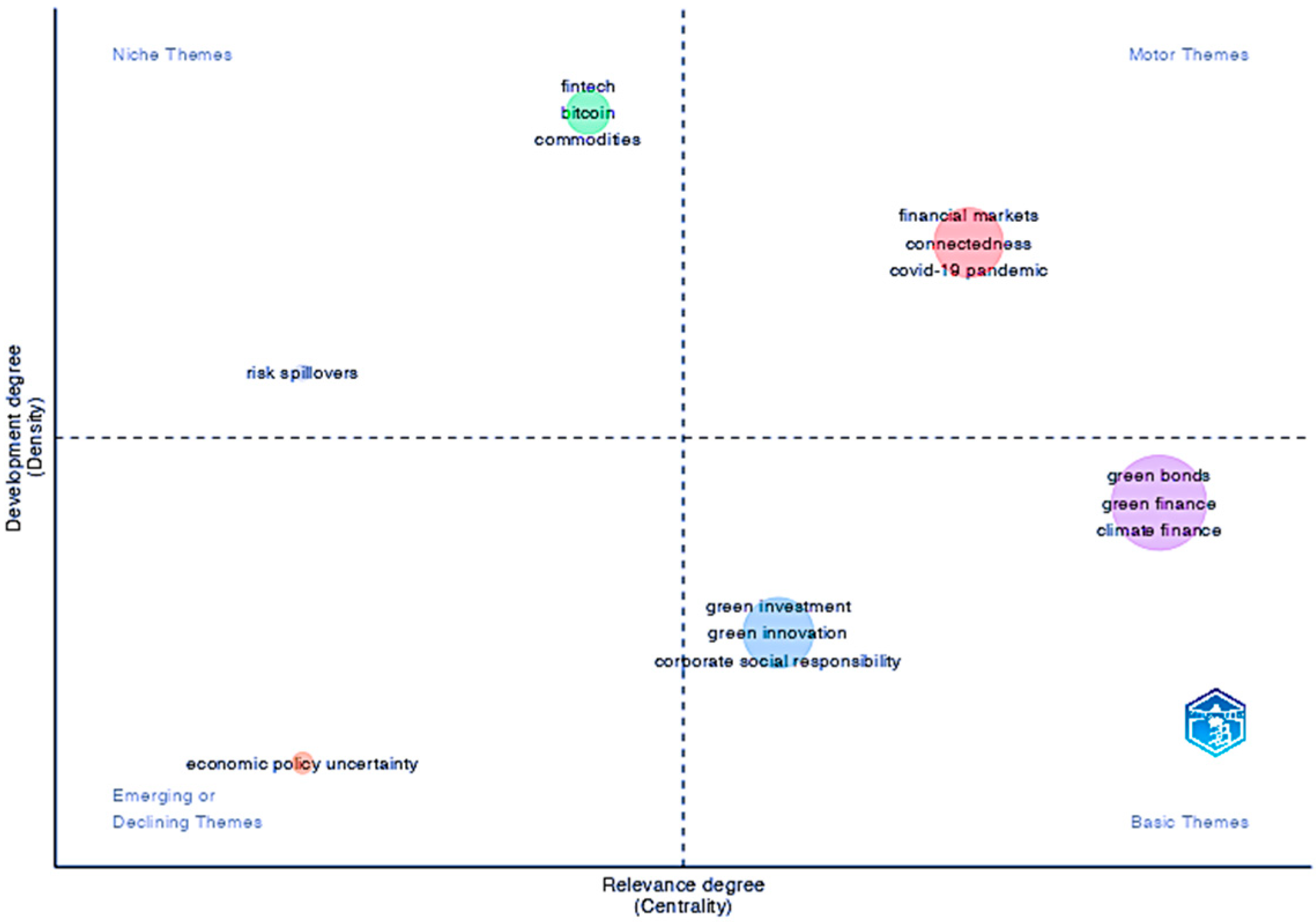
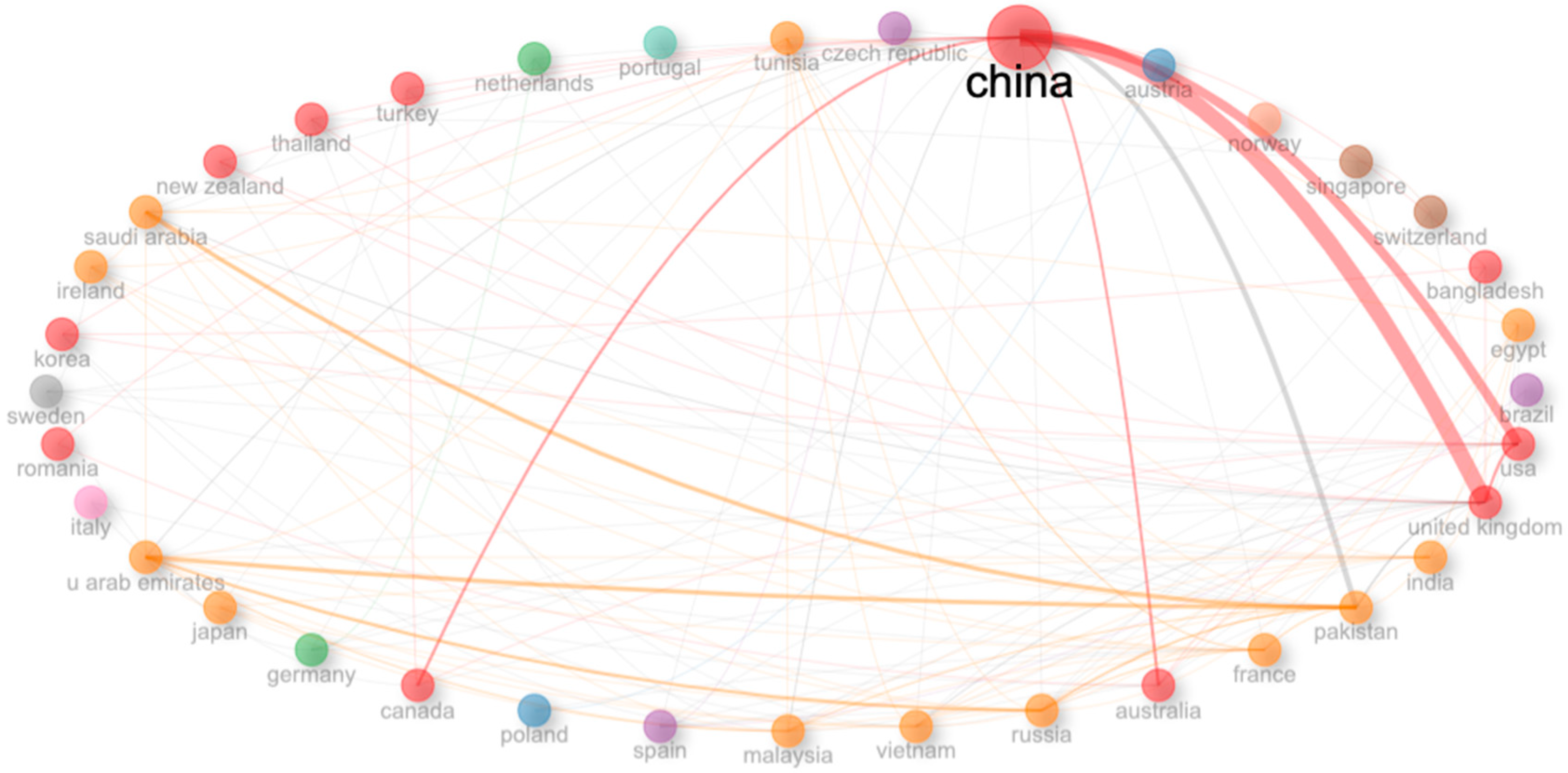
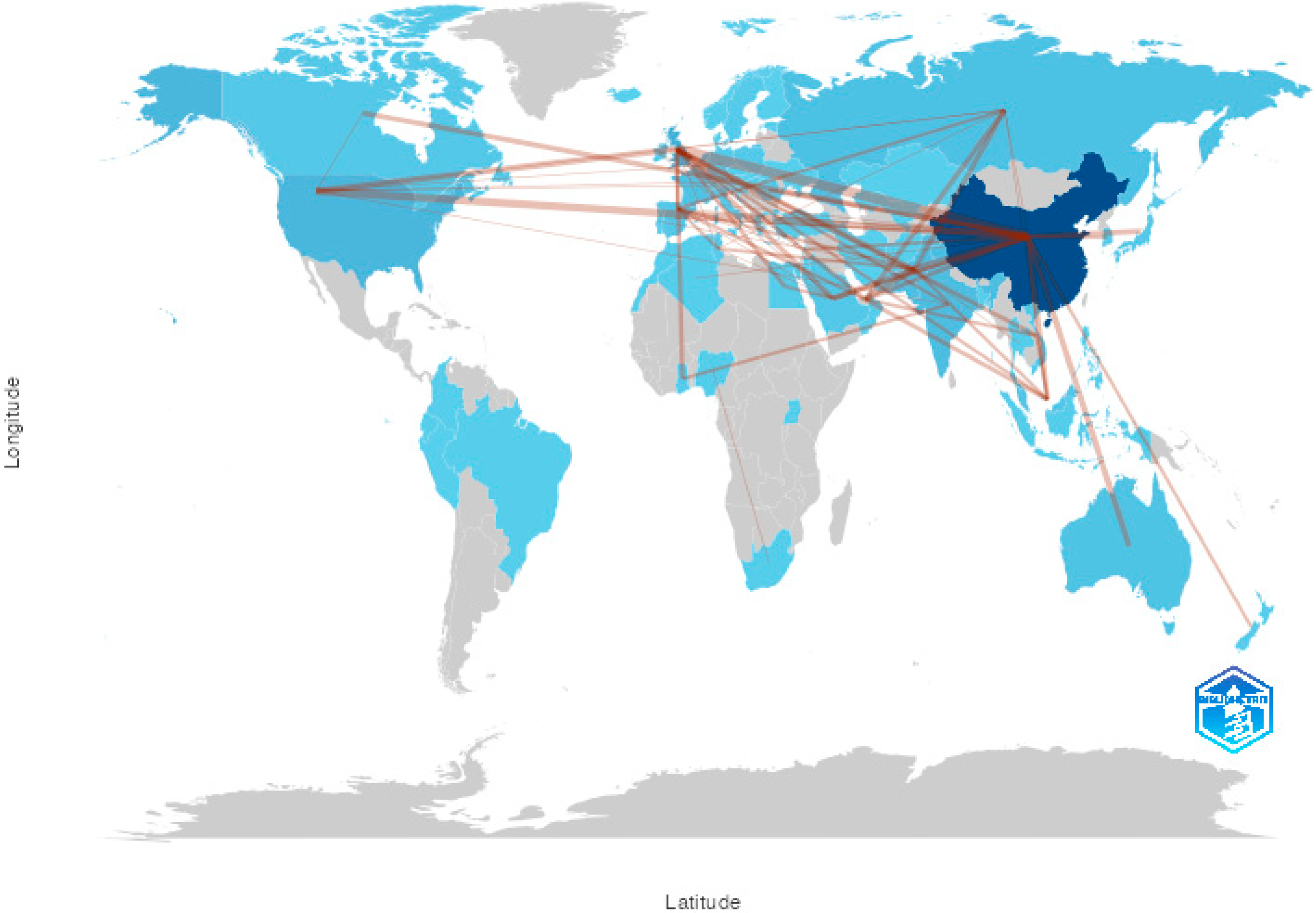
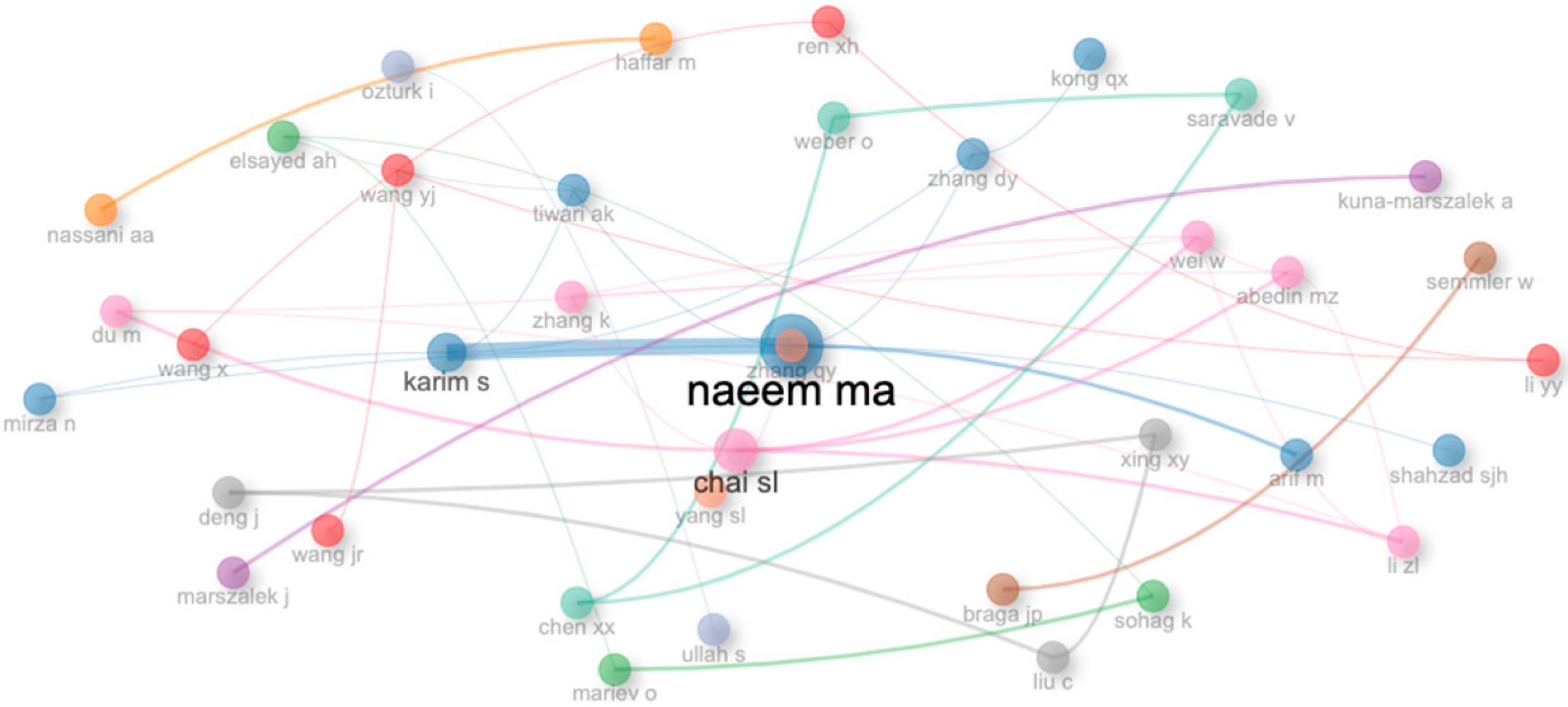
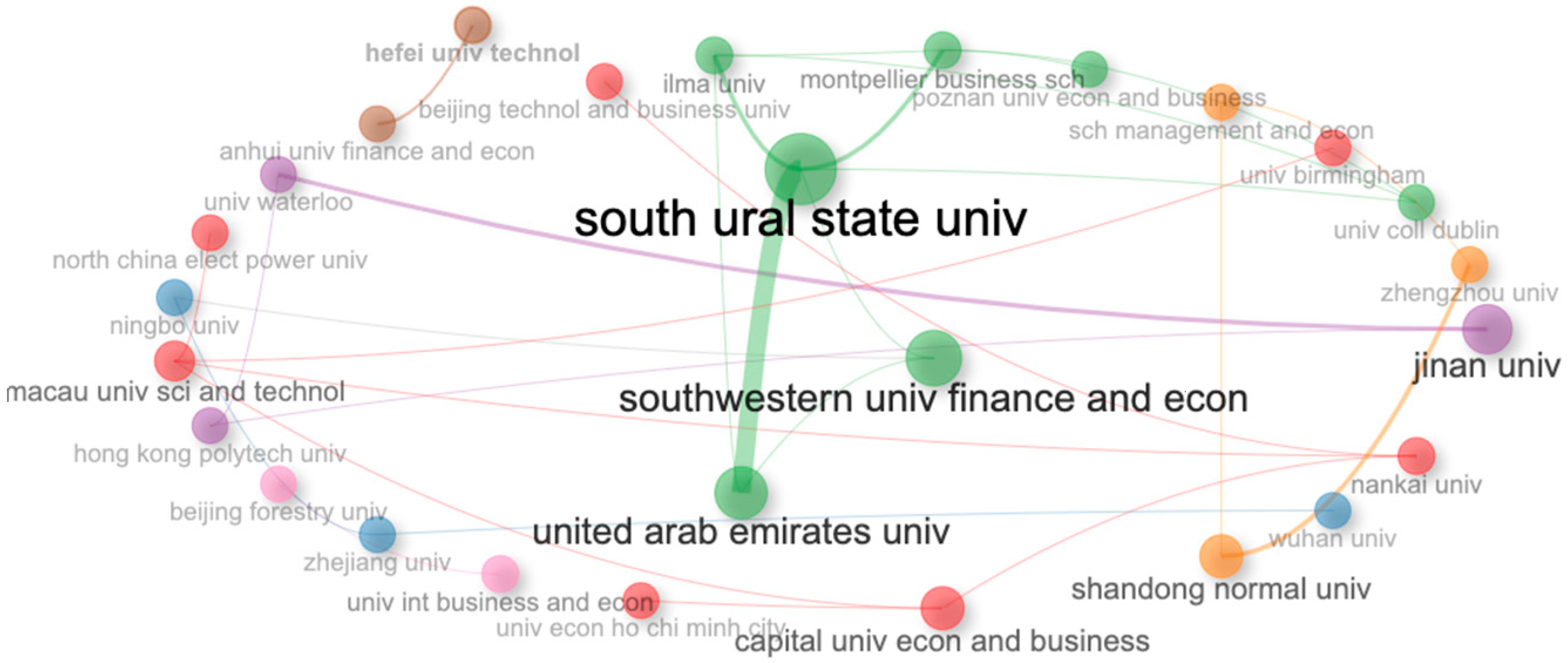
| Year | Articles per Year (N) | Percentage of Total |
|---|---|---|
| 2017 | 9 | 2.87% |
| 2018 | 9 | 2.87% |
| 2019 | 16 | 5.10% |
| 2020 | 19 | 6.05% |
| 2021 | 44 | 14.01% |
| 2022 | 112 | 35.67% |
| 2023 | 105 | 33.44% |
| N | 314 | 100% |
| Source | Rank | Frequency | Cumulative Percentage | Zone |
|---|---|---|---|---|
| Sustainability | 1 | 33 | 10.5% | Zone 1 |
| Energy Economics | 2 | 20 | 16.86% | Zone 1 |
| Journal of Cleaner Production | 3 | 19 | 22.91% | Zone 1 |
| Environmental Science and Pollution Research | 4 | 15 | 27.69% | Zone 1 |
| Resources Policy | 5 | 10 | 30.87% | Zone 1 |
| Renewable Energy | 6 | 7 | 33.1% | Zone 1 |
| Technological Forecasting and Social Change | 7 | 7 | 2.23% | Zone 2 |
| Energy Policy | 8 | 6 | 35.33% | Zone 2 |
| Finance Research Letters | 9 | 6 | 37.24% | Zone 2 |
| Journal of Sustainable Finance & Investment | 10 | 6 | 39.15% | Zone 2 |
| Economic Research-Ekonomska Istraživanja | 11 | 5 | 40.74% | Zone 2 |
| Frontiers in Environmental Science | 12 | 5 | 42.33% | Zone 2 |
| International Journal of Environmental Research and Public Health | 13 | 5 | 43.92% | Zone 2 |
| Business Strategy and the Environment | 14 | 3 | 44.88% | Zone 2 |
| Climate Policy | 15 | 3 | 46.8% | Zone 2 |
| Economic Analysis and Policy | 16 | 3 | 47.76% | Zone 2 |
| Frontiers in Energy Research | 17 | 3 | 48.72% | Zone 2 |
| Frontiers in Public Health | 18 | 3 | 49.68% | Zone 2 |
| Green Finance | 19 | 3 | 50.64% | Zone 2 |
| Heliyon | 20 | 3 | 51.6% | Zone 2 |
| Zone | Number of Journals | Number of Articles | ||
|---|---|---|---|---|
| N | % | N | % | |
| Zone 1 | 6 | 4.255% | 104 | 33.12% |
| Zone 2 | 36 | 25.53% | 107 | 34.08% |
| Zone 3 | 99 | 70% | 103 | 32.80% |
| Total | 141 | 314 | ||
| Sources | Article Citations |
|---|---|
| Energy Economics | 894 |
| Journal of Clean Production | 724 |
| Finance Research Letters | 498 |
| Energy Policy | 362 |
| Sustainability | 351 |
| Resources Policy | 291 |
| Environmental Science and Pollution Research | 254 |
| Journal of Financial Economics | 245 |
| Technological Forecasting and Social Change | 239 |
| International Review of Financial Analysis | 209 |
| No of Articles | No of Authors | Frequency (%) |
|---|---|---|
| 1 | 826 | 91.68% |
| 2 | 63 | 7% |
| 3 | 5 | 0.55% |
| 4 | 1 | 0.11% |
| 5 | 4 | 0.44% |
| 6 | 1 | 0.11% |
| 9 | 1 | 0.11% |
| Words | Occurrences |
|---|---|
| Green bonds | 102 |
| Green finance | 58 |
| Sustainable development | 23 |
| China | 21 |
| Climate change | 18 |
| Climate finance | 18 |
| COVID-19 | 17 |
| Green investment | 17 |
| Green innovation | 15 |
| Financial markets | 11 |
| ESG | 11 |
| Clean energy | 9 |
| Country 1 | Country 2 | Frequency | Percentage |
|---|---|---|---|
| China | United Kingdom | 17 | 22.08% |
| China | Pakistan | 10 | 12.99% |
| China | USA | 10 | 12.99% |
| United Kingdom | USA | 7 | 9.09% |
| China | Australia | 6 | 7.79% |
| Pakistan | Saudi Arabia | 6 | 7.79% |
| Pakistan | United Arab Emirates | 6 | 7.79% |
| China | Canada | 5 | 6.49% |
| China | Japan | 5 | 6.49% |
| China | Malaysia | 5 | 6.49% |
Disclaimer/Publisher’s Note: The statements, opinions and data contained in all publications are solely those of the individual author(s) and contributor(s) and not of MDPI and/or the editor(s). MDPI and/or the editor(s) disclaim responsibility for any injury to people or property resulting from any ideas, methods, instructions or products referred to in the content. |
© 2024 by the authors. Licensee MDPI, Basel, Switzerland. This article is an open access article distributed under the terms and conditions of the Creative Commons Attribution (CC BY) license (https://creativecommons.org/licenses/by/4.0/).
Share and Cite
Maina, P.; Gyenge, B.; Fekete-Farkas, M.; Parádi-Dolgos, A. Analyzing Trends in Green Financial Instrument Issuance for Climate Finance in Capital Markets. J. Risk Financial Manag. 2024, 17, 145. https://doi.org/10.3390/jrfm17040145
Maina P, Gyenge B, Fekete-Farkas M, Parádi-Dolgos A. Analyzing Trends in Green Financial Instrument Issuance for Climate Finance in Capital Markets. Journal of Risk and Financial Management. 2024; 17(4):145. https://doi.org/10.3390/jrfm17040145
Chicago/Turabian StyleMaina, Purity, Balázs Gyenge, Mária Fekete-Farkas, and Anett Parádi-Dolgos. 2024. "Analyzing Trends in Green Financial Instrument Issuance for Climate Finance in Capital Markets" Journal of Risk and Financial Management 17, no. 4: 145. https://doi.org/10.3390/jrfm17040145
APA StyleMaina, P., Gyenge, B., Fekete-Farkas, M., & Parádi-Dolgos, A. (2024). Analyzing Trends in Green Financial Instrument Issuance for Climate Finance in Capital Markets. Journal of Risk and Financial Management, 17(4), 145. https://doi.org/10.3390/jrfm17040145







